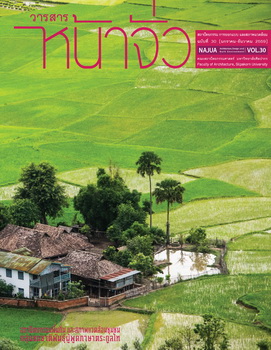การแปรเปลี่ยนลักษณะกลุ่มบ้านของชุมชนสะเทินนํ้าสะเทินบกในที่ราบลุ่มเจ้าพระยา
คำสำคัญ:
ชุมชนสะเทินน้ำสะเทินบก, การแปรเปลี่ยน, การเชื่อมต่อสัญจร, พื้นที่อยู่อาศัย, ความดั้งเดิม, สมัยใหม่, Amphibious settlement, Change, Connectivity, Living space, Tradition, Modernityบทคัดย่อ
การตั้งถิ่นฐานของชุมชนสะเทินนํ้าสะเทินบก ทำให้เห็นถึงภูมิปัญญาของการอยู่อาศัยท่ามกลางการแปรเปลี่ยนของเวลาและสภาพแวดล้อมในที่ราบลุ่มเจ้าพระยาที่เป็นบริเวณพื้นที่น้ำท่วมถึงในภาคกลางของประเทศไทย นอกจากนี้การปรับตัวในพื้นที่อยู่อาศัยระดับต่างๆ เกิดขึ้นเพื่อให้สอดรับกับถนนและโครงสร้างพื้นฐานที่เข้ามาในพื้นที่ชุมชนสะเทินนํ้า สะเทินบกเพื่อให้สามารถอยู่ร่วมกับสภาวะนํ้าท่วมนํ้าหลากที่ยังคงเผชิญอยู่ในปัจจุบัน
บทความนี้มีวัตถุประสงค์เพื่อทำความเข้าใจการแปรเปลี่ยนของผังหมู่บ้าน อันเป็นองค์ประกอบที่สำคัญของพื้นที่อยู่อาศัยของการตั้งถิ่นฐานที่สามารถอยู่ร่วมกับสภาพแวดล้อมสะเทินนํ้าสะเทินบกมาได้นับแต่อดีต ซึ่งมีลักษณะทางกายภาพที่แปรเปลี่ยนไปจากการเข้ามาของถนนและโครงสร้างพื้นฐาน โดยการศึกษานี้ทำการเลือกชุมชนกรณีศึกษาในจังหวัดพระนครศรีอยุธยา 3 หมู่บ้านที่ยังคงสะท้อนภาพลักษณ์ของความเป็นชุมชนสะเทินนํ้าสะเทินบก ซึ่งเป็นหมู่บ้านที่ยังคงประกอบไปด้วยกลุ่มเรือนไทยใต้ถุนสูง และยังคงมีวิถีชีวิตที่ยังผูกพันกับการทำนา คือ บ้านคลองมอญ ตำบลลาดงา อำเภอเสนา บ้านหนองตะเกียง ตำบลลาดชิด อำเภอผักไห่ และบ้านขอม ตำบลวัดยม อำเภอบางบาล การศึกษานี้มีการเก็บข้อมูลโดยใช้วิธีการสังเกต และการสัมภาษณ์เชิงลึกจากผู้ให้ข้อมูลหลักและใช้การวิเคราะห์หลายลักษณะเพื่อให้เห็นถึงรูปแบบของการสัญจร การเชื่อมต่อ และการใช้พื้นที่อยู่อาศัย ในช่วงเวลาหน้าแล้ง และหน้านํ้า
ข้อค้นพบจากการศึกษาพบว่า การแปรเปลี่ยนลักษณะกลุ่มบ้านของชุมชนสะเทินนํ้าสะเทินบกส่งผลต่อการเชื่อมต่อสัญจรของพื้นที่ใช้สอยและพื้นที่กิจกรรมในระดับต่างๆ การใช้งานและความสัมพันธ์ของพื้นที่ว่างในสภาวะสองฤดู และการดำรงรักษาภาพลักษณ์ของชุมชนสะเทินนํ้าสะเทินบก การแปรเปลี่ยนและการปรับตัวที่เหมาะสมเกิดจากการอยู่ร่วมกันของภาพลักษณ์ดั้งเดิมของชุมชนและภาวะสมัยใหม่อย่างสมดุล
Changes to Housing Clusters of Amphibious Settlements in Chao Phraya River Basin
Poon Khwansuwan
Ph.D. in Built Environment Program, Faculty of Architecture, Kasetsart University
Wandee Pinijvarasin
Faculty of Architecture, Kasetsart University
Ornsiri Panin
Faculty of Architecture, Kasetsart University
Amphibious settlements along Chao Phraya River in the central part of Thailand reflect folk wisdoms in adapting to temporal and environmental changes. Such adaptation was necessitated by the growth and infrastructural developments, which include roads and highways, so that traditional lifestyle may be able to endure under the often inundated conditions resulting from such developments.
This paper looks at changes in the layout of the villages, which is an important aspect of traditional way of life in terms of setting up amphibious settlements. Since the past, these settlements have coexisted in harmony with environmental conditions, but the introduction of roads and other infrastructures has led to changes in their physical characteristics. Three village communities in Ayutthaya province were selected as case studies. Each village still has traditional Thai houses that are raised on stilts with amphibious characteristics, and people depend on rice farming for their livelihood. The three villages are: Baan Klongmon (Tambon Lad-nga, Sena district), Baan Nongtakiang (Tambon Ladchid, Pakhai district), and Baan Khom (Tambon Watyom, Bangban district). Information was obtained through observations and interviews with key individuals. Various analyses were made in order to identify the communication routes and linkages as well as the use of dwelling spaces during both dry and flooding seasons.
Findings indicate that changes in housing clusters of the villages affect the communication routes and use of spaces for various activities at different levels during the two seasons. However, due to the preservation of amphibian identity, together with appropriate changes and adaptations, they have been able to still retain a harmonious and balanced integration of the old and the new.





